Captain’s Blog
Saturday
July 25, 2009
We decided to head out to Jasper National Park along the Ice Fields Parkway but not before stopping to gas the MH. What a surprise when we arrived at the gas station. It was 9:30 AM and the cars were lined up in the streets. Of course we had the MH and tow vehicle so getting into the station was a challenge. Once at the pump we were OK but I had to go in and drop off the credit card before Ron could fill the tank. I asked the man why so many people at the pumps and he told me the other gas station in town ran out of fuel and if he didn’t get his shipment in he would too. There was only regular gas left at his station. Lucky for us we only needed ½ tank. The fuel here is outrageous at $3.99 gal.
To travel the Ice Fields Parkway you have to have a park pass and of course ours had expired. The girl at the booth was very nice and although we didn’t qualify for the senior pass (age 65 in Canada) she gave us one anyway. The Ice Fields Parkway is a 230 Kilometer scenic roadway with no gas stations so the girl asked us if we had enough gas. Since we had just filled up we were OK but she told us that the gas station at the end of the Parkway and one in Jasper had also run out. I’m not sure if this is normal but it sure doesn’t seem so.
The Icefields Parkway is considered one of the most beautiful scenic roads. It claims 230 kilometers of continuous World Heritage Site scenery completely protected in two national parks. The road runs between Lake Louise and Jasper and it is considered a scenic drive not a transportation corridor therefore a park pass is required.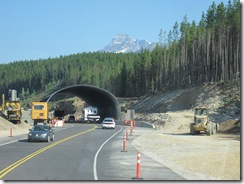

Along the Parkway we stopped to take in the many vistas and waterfalls inclu ding Sunwapta
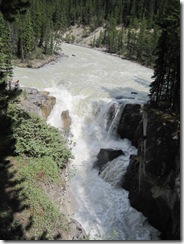 and Athabasca Falls. The Icefields Parkway passes within viewing of seven glaciers and about twenty smaller glaciers but the centerpiece is the Columbian Icefield, largest in the Rocky Mountains with an area of about 200 km
and Athabasca Falls. The Icefields Parkway passes within viewing of seven glaciers and about twenty smaller glaciers but the centerpiece is the Columbian Icefield, largest in the Rocky Mountains with an area of about 200 km
Glaciers form from layers of snow that remain after each summer’s melt. The delicate snowflakes gradually change to hard, interlocking ice crystals. Some glacial ice in the Rockies is hundreds, possibly thousands of years old.
Below the enormous crushing weight of its surface layers a glacier becomes elastic and flows slowly downhill like a river of taffy. The Athabasca Glacier moves forward 15-20 meters per year in the lower part but much faster, up to 127 meters per year in the upper part where it tumbles down from the Columbian Icefield like a waterfall of ice.
At the lower end of the glacier, the ice melts back while the glacier moves forward. During hot dry summers the rate of melting increases and the glacier melts back faster than the forward ice flow, so the toe retreats. In a period of cool cloudy summers the rate of melting decreases and the toe gains ground then the glacier advances. These days the Athabasca Glacier, like most other glaciers is retreating rapidly, an indication that the earth’s climate is warming.

Since this was a once in a lifetime opportunity we decided to take the Brewster Columbia Icefield Experience and ride the Ice Explorer onto the surface of the Athabasca Glacier. Standing at the visitor center the Ice Explorer’s looked like matchbox cars on a massive field of white. You really couldn’t tell what they were – bugs moving around????? The Ice Explorers are huge and specifically built for glacier terrain. 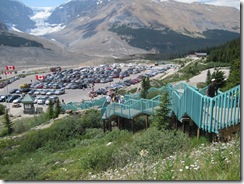 Once we reached the ice falls and head wall of the Athabasca Glacier we were allowed to disembark and walk around on the glacial ice. We brought two empty water bottles and filled them with the ice-cold glacial water. What a treat for us, the water was great, walking on the glacier was a blast and the freezing cold air felt wonderful since the temp at the visitor center was ninety-degrees.
Once we reached the ice falls and head wall of the Athabasca Glacier we were allowed to disembark and walk around on the glacial ice. We brought two empty water bottles and filled them with the ice-cold glacial water. What a treat for us, the water was great, walking on the glacier was a blast and the freezing cold air felt wonderful since the temp at the visitor center was ninety-degrees.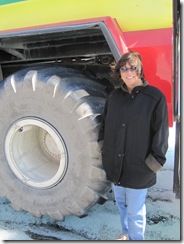
The Columbian Icefield is 130 square miles, is the largest body of ice in the Rocky Mountains, is 1200 feet at its greatest depth, has an average snowfall of 23 feet per year and drains into the Pacific, Arctic and Atlantic Oceans. WOW!!! The Athabasca Glacier is 2.5 miles by 3.75 miles, 270-1000 feet deep.
an average snowfall of 23 feet per year and drains into the Pacific, Arctic and Atlantic Oceans. WOW!!! The Athabasca Glacier is 2.5 miles by 3.75 miles, 270-1000 feet deep.
After leaving the Icefield we continued on to Jasper. The 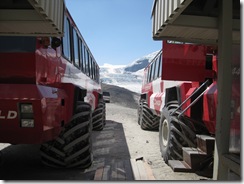
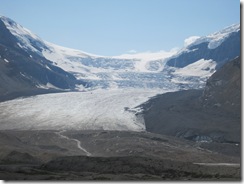 temperature was soaring and the sun brutal. When we arrived in Jasper of course there were no available campsites anywhere to be found.
temperature was soaring and the sun brutal. When we arrived in Jasper of course there were no available campsites anywhere to be found.
This was our welcoming committee just before getting into the overflow campground area.
We were routed to another overflow campground twelve miles away. It turned out to be a great place in the valley with 360 degrees of mountains around us.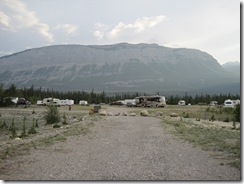
We were both exhausted because we usually don’t sit still for very long. We took advantage of the cool breeze that had come in with the mountain storms in the area. The lighting over the mountains was a beautiful sight to see.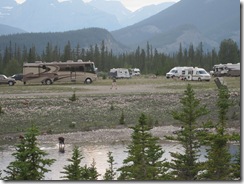
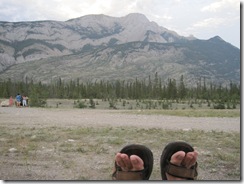
I think Ron finally figured out that during peak season we really do need reservations.
r0n NOTE, NA

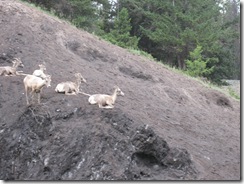

No comments:
Post a Comment